PHOTOGRAPH READING AND INTERPRETATION
Types of Photographs
Identify types of photographs
A
photograph is an image or a picture of an object which is recorded by a
camera and then printed on a paper. Photograph interpretation is a
process of reading, measuring and interpreting photographs for obtaining
reliable information about natural or human features and their
environment. In other words, photograph interpretation can be defined as
analysis and examination of photographs so as to be able to identify
natural or artificial features.
Photographs
are classified according to the viewpoint or position from which they
are taken. They can be taken from the ground or from the air. This then
basically gives us three major types of photographs namely, horizontal,
oblique and vertical photographs.
Horizontal or ground photographs
These
are photographs that are taken from the ground when the camera is at
the same level as object(s) being photographed. There are two categories
of horizontal photographs as described below:
Horizontal close-up photographs
These
are categories of horizontal photographs in which the camera focuses on
a particular object such as a house. The object of focus is shown very
clearly. On the other hand, objects in the background are obscured, and
generally, the background is not seen clearly.
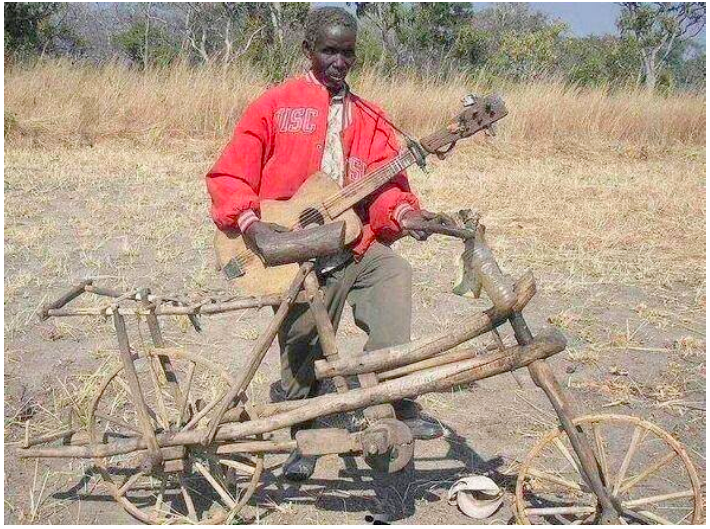
Horizontal general-view photographs
These
are photographs that focus on a wide area of the field. Several objects
are clearly shown in these photographs. Objects close to the camera
appear larger than those far away from the camera. The area whose
objects are obscured from the camera by those objects close to the
camera is called the dead ground.
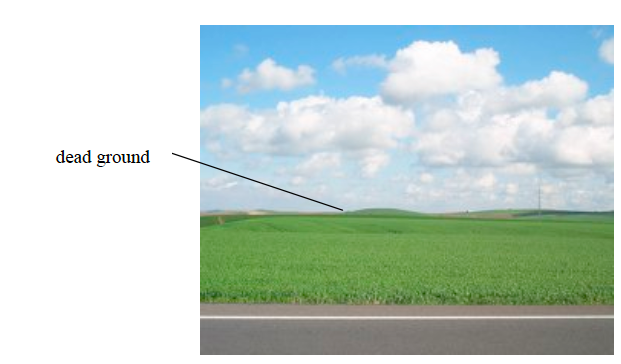
Horizontal general-view photograph
Oblique photographs
These
are types of photographs that are taken from an angle, usually from the
top of a hill, tower or cliff. There are two categories of oblique
photographs as described below:
Ground oblique photographs
These
are taken when the photographer is standing in elevated ground, such as
top of a hill, building or cliff, and holds the camera at an angle
pointing towards the lower ground. The photograph can also be taken when
the photographer is standing at the bottom of an elevated ground, with
the camera pointing towards the higher ground (See the photograph
below). So, whether the photograph is taken from the top or bottom of an
elevated ground, the resulting photograph is called ground oblique
photograph. In this kind of photograph, the images closer to the camera
are larger than those far away.
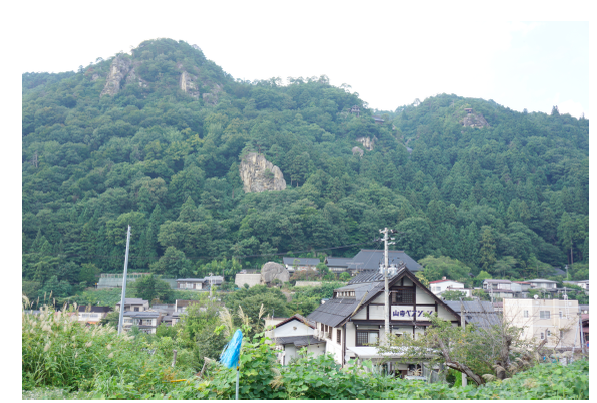
Ground oblique photograph
Aerial oblique photographs
These
photographs are taken from the sky with the camera tilted at an angle
towards the ground.
The photographer may take the photograph from a
helicopter or low-flying aeroplane.
These photographs cover quite a
large area of land. They are similar in many ways to the ground oblique
photographs. Objects near the camera appear slightly larger than those
far away.
An
aerial oblique photograph which does not cover the horizon is called a
low aerial oblique photograph, while that which includes the horizon is
called a high aerial oblique photograph.
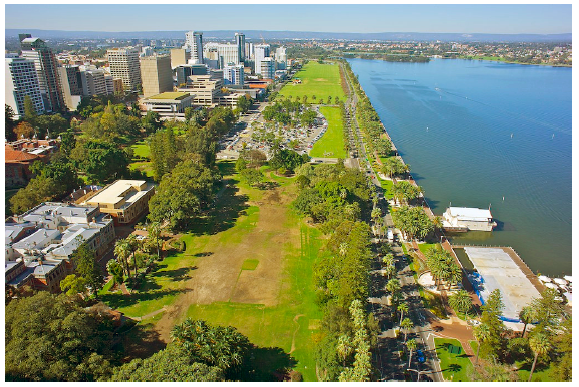
LOW aerial oblique photograph
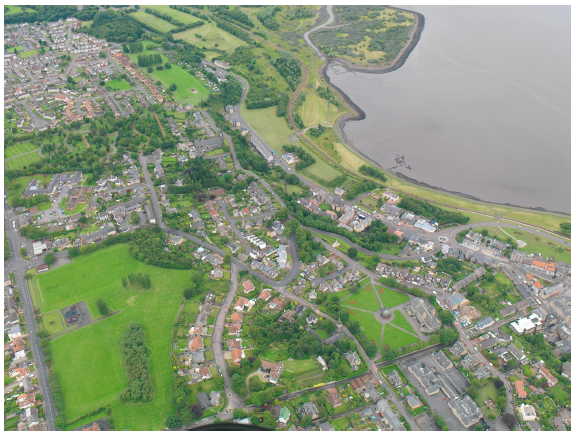
HIGH aerial oblique photograph
Vertical photographs
These
photographs are the ones that are taken from the air with the camera
directly above the scenery, pointing vertically to the ground. The
camera focuses on specific features on the ground though the area
surrounding those features is also shown.
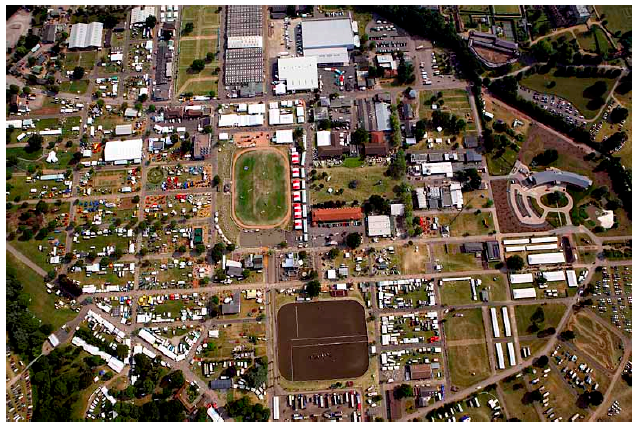
Vertical aerial photograph
Differences between Ground, Vertical and Oblique Photographs
Differentiate between ground, vertical and oblique photographs
A photograph has three parts as described below:
- Background – the area furthest from the camera.
- Foreground – the area nearest to the camera.
- Middle ground – the area between the background and the foreground, which is at middle distance from the camera.
Each
of the three parts of the photograph can further be sub-divided into
three parts to give nine combinations which form the nine minor parts of
the photograph as shown in the table below:
| Left | Centre | Right |
| Left background | Centre background | Right background |
| Left middle ground | Centre middle ground | Right middle ground |
| Left foreground | Centre foreground | Right foreground |
For
easy description of locations on a photograph, it is appropriate to use
these divisions. It is inappropriate to use such terms as ‘top’ or
‘bottom’ when referring to areas or parts of a photograph. Also it is
not acceptable to use points of the compass such as ‘east’, or ‘north’
unless there is sufficient information to enable one to determine the
compass directions of the photograph.
Reading and Interpreting Photographs
Natural and Manmade Features in the Fore, Middle and Background of the Photograph
Identify natural and manmade features in the fore, middle and background of the photograph
Many
physical features shown in the photograph can be identified and
interpreted. These features include relief, drainage, and vegetation,
among others.
Relief
Before
interpretation of other physical features, it is important to first
identify relief features on the photograph. Start by giving a general
idea about the area shown in the photograph. In describing landscape and
landforms, it is important to go even further and describe the forces
and processes that are responsible for their formation and modification.
This is an essential aspect of relief interpretation. Relief features
in the photograph may include the following features:
Flat landscapes
These
landscapes occur both in lowland and highland areas. They are called
plains in the lowlands and plateaus in the highlands. Plains altitudes
are less than 500 metres while plateau altitudes are more than 500
metres above sea level.
It
is impossible to tell the average area of the land directly from a
photograph. However, other features appearing in the photograph, such as
part of the sea, crops and other economic activities may be used in
estimating the altitude. Where there is an accompanying topographical
map of the area, it would then be easier to state the height of the land
from the map.
Where
there is no sufficient information to tell the height of the land,
relief may be described as flat. One can then suggest that it is
probably a low-lying plain or a plateau surface. Some flat areas may be
described as flat lowlands or highlands.
Hilly areas
A
hilly landscape is shown on photographs as having varied relief of
hills and valleys that are not isolated on a flat landscape. Where hills
appear to have the same height across the entire landscape, such a
landscape is probably a dissected plateau. Streams have cut valleys
across former flat land and some interlocking spurs may be visible
towards valleys. Ridges, escarpments and conical hills may easily be
identified according to their appearance.
Mountainous relief
This
kind of relief stands at an altitude of more than 2000 metres above sea
level. As such, not all rising features identified on photographs are
mountains. The relief of mountainous areas is characterized by very
steep slopes often with no human settlements. The slopes may have
vegetation covering them, which could be forests.
At
much higher levels, snow might be seen. The type of trees growing could
give a clue about the altitude of the land. If there are crops growing
or animals reared, these could also give a clue as to the altitude.
Certain crops such as wheat and apples are high-altitude crops.
Likewise, animals such as merino sheep and dairy cattle are also reared
in high-altitude areas within the tropics.
Identifying
relief features on vertical aerial photographs is not straight-forward.
The following guidelines could assist in identifying different types of
relief:
- Flat areas would appear as areas with light colour tone except in regions covered with dense vegetation such as forested areas. Rivers may have big meanders while roads, footpaths and railways are generally straight, with gentle bends in some places.
- Hilly areas could be identified by examining river streams. The streams could be joining one another and getting wider downstream. Hilly areas are the source of rivers. The colour tone in hilly areas is generally dark.
Drainage
Drainage
features such as rivers, lakes and seas may easily be identified in all
types of photographs. Different aspects of rivers can be studied on a
photograph. These include the shapes of river valleys, stages of
development and various features. Based on the presence of certain
features, one can tell the nature of the rock over which the river
flows. For example, the presence of rapids and waterfalls is an
indication that the river is flowing over steep land. River meanders are
an indication that the river is in it mature or old-age stage.
Interlocking spurs indicate that the river valley is made of alternating
layers of hard and soft rocks.
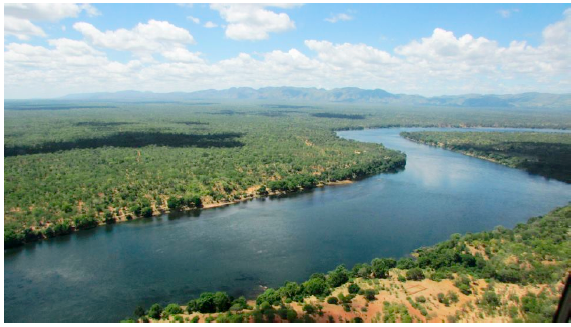
A meandering river
Drainage
patterns are easier to identify on vertical aerial photographs. The
colour tone of areas covering deep water appears darker than those of
shallow water. The various functions of the river can also be
identified.
Vegetation
Photographs
show all types of vegetation in the photographed area. Planted
(artificial) and natural forests appear to be distributed unevenly, with
planted forests usually in clear straight lines. In planted forests
trees tend to be of the same type, size and height because they were
planted at the same time.
The
plant characteristics that may appear on the photograph can be used as a
guide to the general types of vegetation, for example savannah or
semi-arid vegetation. The following guidelines should be used when
describing vegetation on a given photograph:
Identify
the types of vegetation, for example, forests, thickets, grasslands and
swamp plants. Describe the plants, giving details such as height, shape
and appearance of leaves. Where possible, give the names of species of
plants, e.g. jacaranda, cacti, eucalyptus trees, etc. Planted vegetation
should be distinguished from the natural ones by their characteristics.
Proper interpretation of vegetation calls upon application of
geographical knowledge outside the photograph as well.

A planted forest
Soil
A
clue on the type of soil in a photographed area may be given by the
types of crops grown and appearing on the photograph. Rice, for example,
grows well in clay soil. Tea and coffee require volcanic soil. Coconuts
and cashew nuts thrive well in coastal regions with sandy soils, and a
variety of horticultural crops thrive in loam soils.
Proper
interpretation of the soil requires an application of one’s general
knowledge of geography learnt in classroom as well as knowledge from
other disciplines.
Climate
Weather
and climate are not shown directly on photographs. Features contained
in a photograph can be used to make conclusions about the climate of a
photographed area. The type of crops grown and vegetation on the
photograph can be used as a clue to establish the climate of a place.
Vegetation types and crops can also provide evidence about the season or
climate of a place. For example, the presence of many cacti signifies
an arid or semi-arid region, and hence a desert or semi-desert climate.
Crops
such as sisal are grown in hot areas that receive low rainfall while
sugarcane thrives in warm to hot climate with high rainfall. The type of
clothing people in the photograph are wearing can give an indication
about the weather and possible climate.
Interpreting Features Presented on the Photograph
Interpret features presented on the photograph
Human
activities on a photograph are depicted by various forms of land use.
The uses of land may in form of agriculture (crop cultivation and animal
husbandry), forestry, settlement, wildlife conservation, mining and
construction of infrastructures, among other uses.
Agriculture
This
includes crop cultivation and livestock rearing. It is practised at
subsistence and commercial levels. It is easy to identify agricultural
activities on ground photographs. To be able to identify these features
on vertical aerial photographs, it requires close examination of the
features.
Some
evidences that can be used to establish the kind of agricultural
activities taking place in an area shown on the photograph are
summarized in the table below:
| Type of farming | Evidences to look for |
| Subsistence crop farming |
|
| Subsistence livestock farming |
|
| Commercial livestock farming |
|
| Commercial crop farming |
|
| Plantation farming |
|
Not
all the listed evidences in the table for a single type of farming will
be available on a single photograph. However, information available may
suffice to draw conclusions about the type of farming.
Apart
from the types of farming, there are other aspects to be considered
when describing and interpreting photographs. These include:
- farming characteristics and the areas where such a type of farming is practised;
- the advantages and limitations of the type of farming;
- the effects of each type of farming to the environment; and
- the government policy on each type of farming.

Subsistence farming
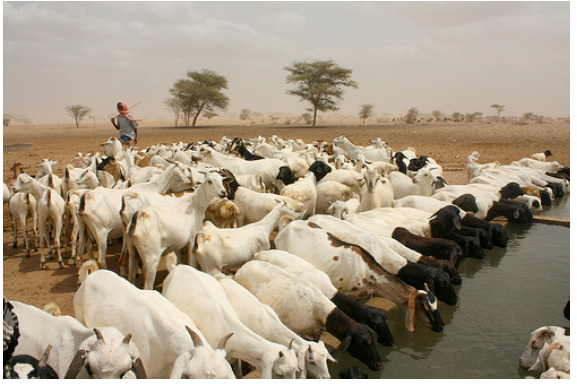
Livestock husbandry
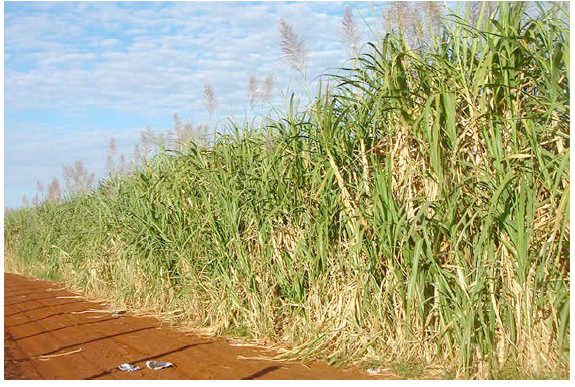
Sugarcane plantation
Settlement
A
settlement comprises of a group of buildings in an area where people
live and carry out social and economic activities. However, some
settlements are made up of institutional, industrial and commercial
buildings most of which may not comprise of living houses. Settlements
may be of two types, namely, rural and urban settlements.
In photographs, rural settlements can be indicated by the following features:
- Many semi-permanent and a few permanent buildings such as grass-thatched houses or iron-roofed houses with mud or brick walls
- Evidence of farming, cattle herding or fishing activities
- Unplanned or unevenly distributed dwellings or presence of villages Planned settlements in rural areas are associated with institutions or plantations.
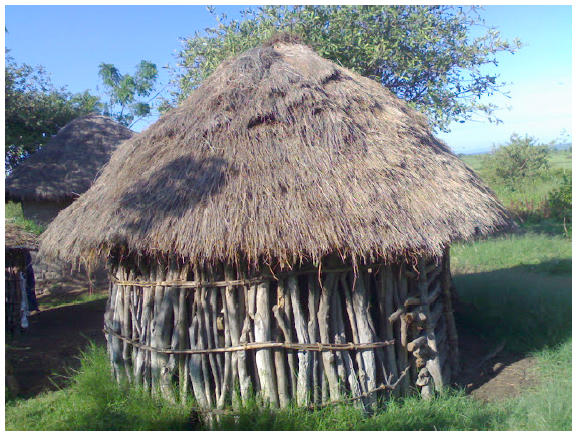
Rural settlement
Urban settlements can be identified by the following features:
- Permanent buildings, which dominate the area
- Regular street patterns
- Buildings with several storeys
- Many large buildings and warehouses indicating an industrial area
- High numbers of people (if they are shown on the photograph)
- Many motor vehicles on the road, which may lead to traffic jams
- Port facilities such as docks, cranes, warehouses and containers

Urban settlement
Not
all the listed evidence above will be found on a single photograph.
However, there should be sufficient evidence to lead one to make a
distinction as to the type of settlement. Settlement patterns can be
easily recognized especially from the ground oblique and aerial
photographs.
Industrial and mining activities
Various
features signalling the presence of industrial and mining activities
may also appear on a photograph. It is important that one is familiar
with a wide variety of photographs on which these features are shown.
The following evidence can be used as a guide in identifying industrial and mining activities on a photograph:
- Factory buildings with tall chimneys that might be issuing a lot of smoke into the air
- Nucleated settlements in the neighbourhood, likely to be the labourers’ houses
- Tall chimneys emitting flames and a network of pipes with large tanks in the distance could indicate an oil refinery
- Large warehouses close to a building that looks like a factory
- Large open pits, large excavators and lorries carrying loads of rocks could indicate open cast mining
- A large area with derricks (oil rigs) could point to an oilfield where oil is mined
Lumbering
Lumbering activities could be indicated by the presence of the following features/activities:
- People cutting trees using manual or power saws
- People loading timber onto lorries or tractor trailers
- Logs floating down the river
- Logs piled near a saw mill
- Large forest clearings with tree stumps and piles of logs
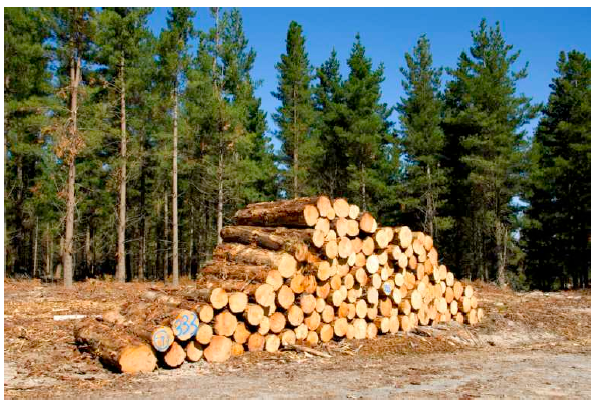
A pile of logs
Transport and communication
Various
forms of transport and communication appear differently on photographs.
Modes and means of transport can also be identified on a photograph.
The following are some of the clues on transport:
- Motor vehicles and roads
- A railway line with or without a train; or just the presence of a named railway station
- A large tamaracked or murram road with buildings on one side, a control tower. Aeroplanes may be seen, or just the presence of a named or symbolized airport may be indicated on a photograph.
- Presence of ports, boats, ships or large water bodies
- Animals carrying loads on their backs
Facilities
for communication may be indicated by the presence of telephone lines,
telephone booths, satellite dishes, buildings with masts and wires
connecting the masts, post office, radio or television station,
newspapers or newspaper stands, etc. Other human activities represented
on photographs can also have relevant clues that enable one to identify
the presence of given communication facilities.

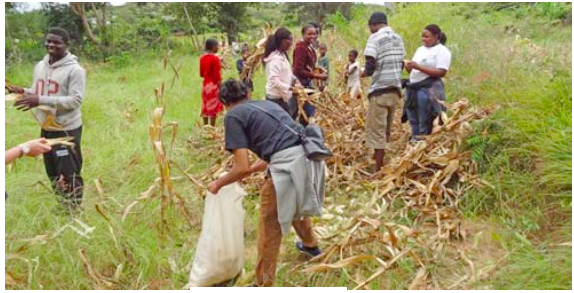

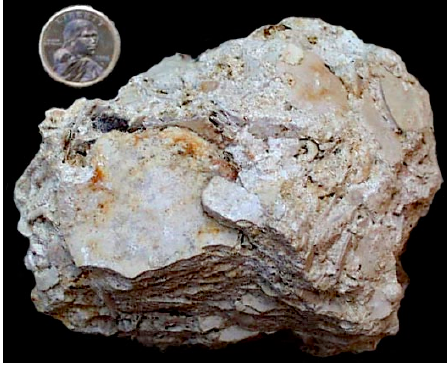

No comments